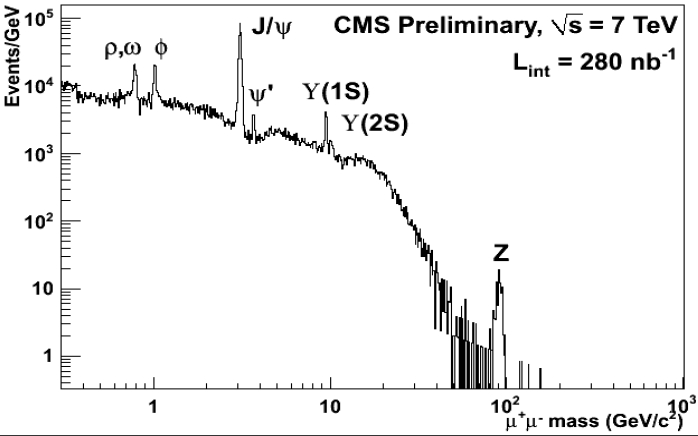If you do not like the figure below, courtesy CMS Collaboration 2010, you are kindly requested to leave this blog and spend your time reading something else than fundamental physics. I do not know what will ever make you believe particle physics is beautiful, if not what is shown here.

The figure shows, using a logarithmic scale on both axes, the reconstructed mass of pairs of muon candidates of opposite charge, collected by CMS in its first 280 inverse nanobarns of 7-TeV proton-proton collisions collected until a week ago. Nothing fancy has been done to prettify this graph: these are honest-to-god muon pairs, as Nature (the bitch, not the magazine) has produced them in the core of CMS. True, the interecession of a detector and a reconstruction software were needed to go from ionization clouds to event counts; but this is the absolute minimum of manipulation you can ever expect from particle signals.
Now, what should enthuse you about the graph is the following. The distribution reveals, clearer than a million words could describe, the structure of all the most important bound states decaying by electroweak interactions into pairs of muons which we can produce in hadron collisions. We immediately spot the Z boson on the far right, and the towering peak of J/Psi mesons; but we also see Upsilon mesons, and at lower energy, we detect the ligher resonance decays of rhos, omegas, and phi mesons. What a spectroscopist's delight! This figure is tremendously informative! If we sent it to outer space, without labels or units, no intelligent race could ever mistake its meaning!
You also notice that these jewels stand atop a background of unidentified muon pairs. Muons can be produced singly by the weak decay of kaons and pions, for instance, or even more massive states like bottom and charm. Occasionally, pairs of muons of opposite charge can emerge that do not have the same parent: the frequent production of these uncorrelated pairs creates the significant backgrounds you see in the picture. Note, however, how these backgrounds die out for large dimuon masses: the Z boson is basically background-free, a fact I have noted in my previous posting here.
As these pages testify, CMS and ATLAS have presented scores of interesting physics results at ICHEP this week. None of those were groundbreaking ones; a few were significant advances, though, and many others were just meant to demonstrate that the experiments are ready for big challenges, such as discovering new physics, the Higgs, measuring the top mass better than the Tevatron, etcetera. The presented results took about a hundred man-years to produce, and I have a lot of respect for them -not to mention the fact that I did my little bit to contribute. But it is my humble opinion that the graph shown above could well be the one to single out and attach on the bulletin board of all the universities and institutes participating in the LHC experiments!

This is indeed nice Tommaso, but I was wondering: do you just blog about CMS results? :-)
ReplyDeleteI wonder what will emerge beyond the Z0 when integrated luminosity eventually reaches several inverse fb ;-)
ReplyDeleteI am wondering who has the copyright for the graph above.
ReplyDeleteIt was also posted here:
http://www.evz.ro/detalii/stiri/povestea-fizicii-particulelor-ce-se-cauta-in-tunelul-de-la-geneva-901856/pagina-comentarii/1.html#comentarii
And your blog just briefly mentioned...
Well, once presented (or published) all these plots are public, so you are free to use them elsewhere, but you cannot modify them (e.g. erasing the 'CMS' label!), and you should always quote a reference.
ReplyDelete